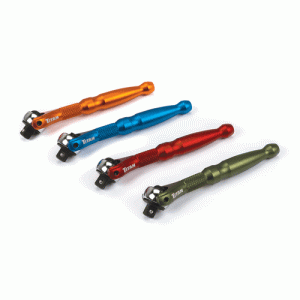Safety should always be a top priority when driving, whether you're heading to work, running errands, or embarking on a long road trip. Equipping your vehicle with the right automotive safety gear can prevent accidents, protect passengers, and ensure you're prepared for emergencies.
At Automotive Tools and Supplies, we understand the importance of having high-quality automotive safety gear in every vehicle. This guide will walk you through the essential safety equipment you need and how to choose the best options for your car.
Why Automotive Safety Gear Is Essential
Car accidents and roadside emergencies can happen anytime. Having the right automotive safety gear can:
✔️ Prevent accidents by improving visibility and control.
✔️ Protect passengers in case of a collision.
✔️ Assist with breakdowns by providing tools to fix minor issues.
✔️ Ensure fast response in case of a medical or fire emergency.
Investing in quality safety gear is not just about complying with regulations—it’s about ensuring a safer driving experience for you and others on the road.
Essential Automotive Safety Gear for Every Car
1. First Aid Kit
A well-equipped first aid kit is a must-have for treating minor injuries on the road.
🔹 Must-Have Items:
Bandages, gauze, and adhesive tape
Antiseptic wipes and antibiotic ointment
Scissors and tweezers
Pain relievers (aspirin or ibuprofen)
Emergency contact numbers
💡 Tip: Keep your first aid kit in an easily accessible location, like the glove box or trunk.
2. Fire Extinguisher
A fire extinguisher is essential for handling small fires caused by fuel leaks, electrical issues, or overheating.
🔹 What to Look For:
ABC-rated extinguisher (works on multiple types of fires)
Compact and easy to mount inside the vehicle
Quick-release bracket for fast access
💡 Tip: Check the expiration date and ensure your extinguisher is in working condition.
3. Emergency Roadside Kit
A roadside emergency kit can help you stay safe if your car breaks down.
🔹 Must-Have Items:
Jumper cables
Reflective safety vest
Road flares or LED warning lights
Tire pressure gauge and inflator
Multi-tool or basic toolset
💡 Tip: Look for kits that include a flashlight with extra batteries for nighttime emergencies.
4. Tire Repair and Maintenance Tools
Flat tires are common, and having the right automotive safety gear can get you back on the road quickly.
🔹 Essential Tire Safety Tools:
Spare tire (properly inflated)
Tire jack and lug wrench
Tire sealant or plug kit for temporary fixes
Portable air compressor for tire inflation
💡 Tip: Regularly inspect your spare tire to ensure it's ready for use.
5. Seat Belt Cutter and Window Breaker
If you’re ever trapped in your car after an accident, a seat belt cutter and window breaker can help you escape.
🔹 Features to Consider:
Dual-function tool with a sharp seat belt blade and hardened steel tip for breaking windows
Compact and easy to store in the glove box or center console
Glow-in-the-dark handle for visibility in low light
💡 Tip: Attach it to your keychain or dashboard for quick access.
6. Dash Cam
A dash cam records everything happening on the road, providing evidence in case of an accident.
🔹 Key Features:
High-resolution recording (1080p or higher)
Night vision mode for low-light driving
Loop recording to overwrite old footage
G-sensor to save footage during a collision
💡 Tip: Choose a dash cam with parking mode to record when your car is off.
7. Blind Spot Mirrors or Sensors
Blind spots are a major cause of accidents. Blind spot mirrors or blind spot monitoring systems improve visibility and prevent collisions.
🔹 Options:
Stick-on convex mirrors for side mirrors
Electronic blind spot sensors that alert you to nearby vehicles
💡 Tip: Install mirrors on both side mirrors for an extended field of view.
8. Rearview Camera System
A rearview camera helps prevent back-over accidents and improves parking accuracy.
🔹 Features to Look For:
Wide-angle lens for maximum visibility
Night vision for low-light conditions
Wireless connectivity for easy installation
💡 Tip: Aftermarket rearview cameras are available for older cars without built-in systems.
9. Reflective Triangles and LED Road Flares
If your vehicle breaks down, reflective warning triangles and LED road flares increase visibility, keeping you safe from oncoming traffic.
🔹 Best Options:
Foldable reflective triangles (set of three)
Rechargeable LED road flares with multiple light settings
💡 Tip: Position warning triangles at 10, 50, and 100 feet behind your car.
10. Advanced Safety Features (If Not Already Equipped)
If your car lacks modern safety features, consider upgrading with:
Lane departure warning systems
Adaptive cruise control
Automatic emergency braking (AEB)
Tire pressure monitoring system (TPMS)
💡 Tip: Many of these features are available as aftermarket add-ons.
How to Choose the Best Automotive Safety Gear
When selecting automotive safety gear, consider the following factors:
✅ Quality and Reliability – Choose products from reputable brands with high safety ratings.
✅ Ease of Use – Safety tools should be simple to use in emergencies.
✅ Portability and Storage – Ensure the equipment fits conveniently in your car.
✅ Legal Requirements – Some safety items (e.g., warning triangles) are required by law in certain states.
✅ Climate Considerations – If you drive in extreme weather conditions, invest in climate-specific safety gear (e.g., snow chains).
At Automotive Tools and Supplies, we offer a wide range of automotive safety gear to keep you prepared for any situation.
Final Thoughts
Investing in high-quality automotive safety gear is one of the best decisions you can make as a responsible driver. From first aid kits to dash cams and emergency tools, having the right equipment can mean the difference between a minor inconvenience and a major emergency.
By equipping your car with essential safety tools, you can drive confidently, knowing you're prepared for any situation. Whether you're a daily commuter, a road trip enthusiast, or a professional driver, automotive safety gear is a necessity, not an option.



Write a comment ...